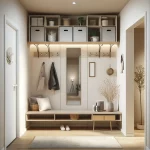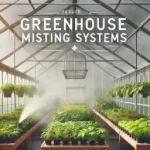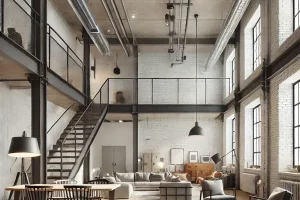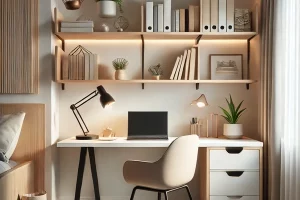Today, we have a cool new way to grow plants called Shipping Container Greenhouses. Imagine a big metal box, like the ones on big ships. Now, imagine it filled with green plants. That’s what this is about!
The best part is it’s also friendly to our Earth. It is called sustainable farming. When we use old boxes for greenhouses, we are not throwing them away, and that’s good. Also, when we grow food near our homes, trucks don’t have to drive far to bring us food. Less truck driving means cleaner air for everyone.
Shipping Container Greenhouses are a fun and smart way to grow our food. They are good for us and good for our planet, too. As we learn about them, we see they help make a greener world, one little green home at a time!
What is a Shipping Container Greenhouse?
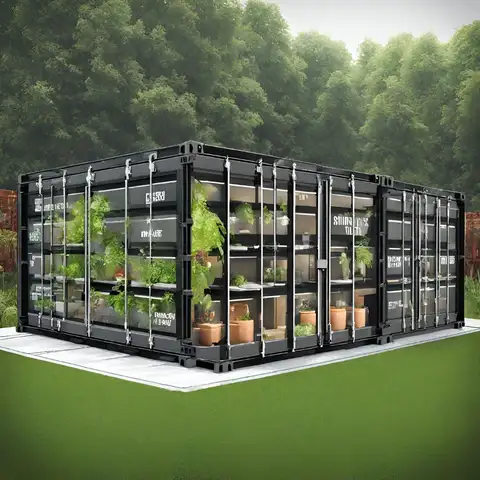
A Shipping Container Greenhouse is a gardening space created from a big metal box. This box, called a shipping container, is changed into a cozy home for plants. It’s a clever way to grow plants, especially where space is tight.
Historical Background and How It Changed Over Time:
Long ago, people only had gardens in the ground. But as cities grew, space became less. Then, some smart thinkers got the idea to use old shipping containers to make green homes for plants. Over time, more people started doing this.
They added windows for light, vents for fresh air, and shelves for plants. This way, Shipping Container Greenhouses became a cool new way to garden. Now, many people use them to grow yummy veggies and pretty flowers right in the city or their backyards.
Advantages of Shipping Container Greenhouses
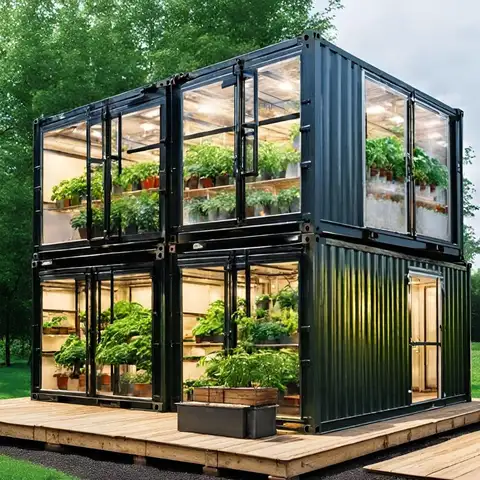
Many people are now turning to Shipping Container Greenhouses for growing plants. They are good for many reasons. Here are some of the big reasons why they are a smart choice:
- Good Use of Space: In cities, there is a limited amount of space for growing plants. But these greenhouses are different. They are made from big metal boxes and use space up and down, not just side to side. This way, even if you have a small area, you can grow many plants. It’s a smart way to farm in the city.
- Saves Money: Old-style greenhouses can take a lot of money to build. But Shipping Container Greenhouses are different. They cost less money to build and to keep running. They also help save water and food for the plants, which saves even more money. So, if you want to start growing plants, this is a cheap way to do it.
- Strong and Lasts Long: These greenhouses are made from strong metal boxes. They can stand strong even when the weather is bad. Wind, snow, or rain, they can handle it all. Unlike other greenhouses that may get damaged, these stay strong and keep your plants safe.
- Easy to Change: One cool thing about these greenhouses is that you can change them easily. If you want to grow more plants, add more metal boxes. You can also add cool stuff like water systems that work on their own. It’s easy to make the greenhouse just the way you want it.
Disadvantages of Shipping Container Greenhouse
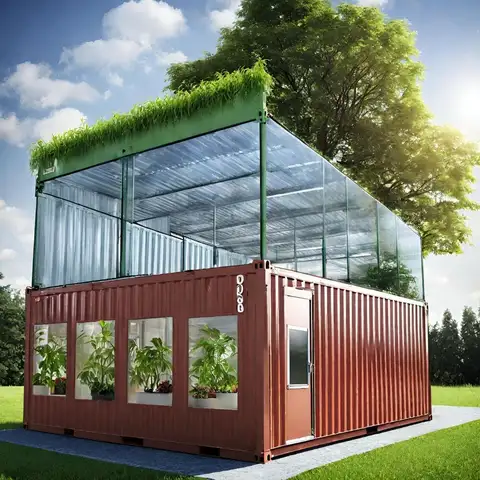
Shipping Container Greenhouses have some downsides, too. Even though they are great in many ways, there are a couple of things that can be challenging. Here, we will talk about two of these challenges: limited space and temperature control.
- Limited Space:
Even though these greenhouses are good at using space wisely, they still have less room compared to regular greenhouses. Regular greenhouses can be built very big if there’s enough land. But with Shipping Container Greenhouses, the space is fixed to the size of the metal box. So, if you want to grow a lot of plants or big plants, it might feel cramped.
- Temperature Control:
Keeping the right temperature inside is very important for the plants to grow well. But it can be hard in a Shipping Container Greenhouse. The metal box can get very hot when the sun shines on it or very cold in chilly weather.
Making sure the temperature stays just right needs extra work. You should get heaters, fans, or shade cloths to help control the temperature.
Ventilation and Climate Control
Growing plants in a Shipping Container Greenhouse is fun, but it also needs some special care. Making sure there’s good air and the right temperature is very important.
Letting Fresh Air In: Best Ventilation Practices
- Passive Ventilation: This is a simple way to let fresh air inside. You can have windows or vents that you can open and close. When they are open, fresh air comes in, and old air goes out.
- Active Ventilation: This is a fancier way. Fans help pull fresh air in and push old air out. It’s a good way to keep air moving, especially when it’s very hot or very cold outside.
Keeping It Warm or Cool: Climate Control Techniques
- Heating: Sometimes, it gets too cold, and we need to warm the greenhouse. Small heaters can help keep the plants warm.
- Cooling: When it’s hot, fans or coolers can help bring the temperature down.
- Shading: Shade cloths can be used to block some sun when it’s too sunny, keeping the inside cool.
Moisture Management
Also, we need to keep the inside dry so that the plants stay healthy. Let’s learn how we can do these things!
- Insulation: Putting some special materials on the walls can help keep moisture away. It helps keep the inside dry.
- Ventilation: Just like we learned before, good ventilation helps keep the air fresh and also helps keep the inside dry.
Cost-effective Venting Solutions
Shipping Container Greenhouse is super important for the plants to grow well. But, sometimes, money can be tight. The good news is there are ways to get good air inside without spending a lot of money. Here, we will talk about some cheapest venting methods that are friendly to your pocket.
DIY Ventilation:
- Make Your Vents: With some simple tools, you can cut out vents or windows in the container. You can cover these openings with mesh or screen to keep bugs out while letting fresh air in.
- Use Old Fans: If you have old fans lying around, you can use them to help move air in and out.
Passive Ventilation:
- Roof Vents: Having vents on the roof can let hot air escape since hot air rises. It’s a natural way to keep fresh air moving without needing power.
- Side Vents: Vents or windows on the sides can also help. When you open them, fresh air comes in and helps push old air out.
Shade and Cool with Nature:
- Plant Trees: Planting trees or tall plants outside can give shade and cool the area around. It can help keep the inside cooler without costing a lot.
Water Cooling:
- Evaporative Coolers: These coolers use water to help cool the air. They can be cheaper to run than regular air conditioners.
Use the Wind:
- Wind-Driven Vents: If you live where it’s windy, having vents that can catch the wind can help pull fresh air in. It’s using natural wind power for free!
Buying and Building Your Shipping Container Greenhouse
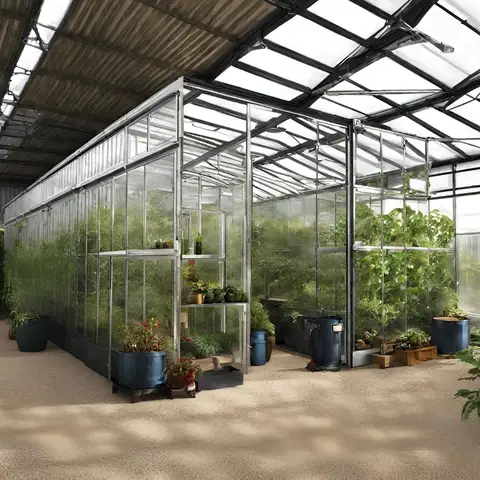
Ready to Buy: Finding Greenhouses for Sale
- Online Marketplaces: Websites like eBay or local online marketplaces often have Shipping Container Greenhouses for sale. You can find one that fits your budget and needs.
- Local Dealers: Some garden centers or greenhouse dealers might have ready-made shipping container greenhouses. It’s a good idea to call around and check.
Do It Yourself: Building Your Greenhouse
- Step 1: Get a Container: Look for a used shipping container online or from a local seller.
- Step 2: Plan Your Space: Decide where you want windows, doors, and vents.
- Step 3: Cut and Install: With the help of an adult, cut out the spaces for windows and vents and install them.
- Step 4: Set Up Inside: Put in shelves, pots, and soil to get ready for planting.
- Step 5: Plant and Grow: Now, plant your seeds or plants and watch them grow!
Regional and Specialized Variants
- Canada’s Cool Greenhouses: In Canada, people use Shipping Container Greenhouses to grow plants all year; they add extra insulation to keep plants warm.
- Urban Farm Units: Modern Farming in the City Urban Farm Units are like tiny farms right in the city. They use shipping containers to grow food close to where people live. It’s a smart way to farm in small spaces.
- Water and Boxes: Hydroponics in Shipping Containers Hydroponics is a way to grow plants in water, not soil. Shipping containers are great for this because they can hold a lot of plants in a small space. It’s like having a small farm right in a box!
Cost Analysis
Starting a garden in a Shipping Container Greenhouse is exciting, but it also costs money. Let’s look at the investment requirements to help you plan better. We will break down the initial and ongoing costs so you know what to expect.
Initial Costs: Getting Started
- Buying the Container: The first thing you need is a shipping container. Used containers can be cheaper than new ones.
- Modifying the Container: You will need to cut out windows, doors, and vents. You might need help from an adult or a professional for this.
- Setting Up Inside: You’ll need shelves, pots, soil, and a watering system to get started. You can save money by using things you already have or finding used items.
Ongoing Costs: Keeping it Growing
- Water: Plants need water. If you live in a dry area, this can cost more.
- Electricity: If you use fans, heaters, or lights, they will need power. It can add to your electric bill.
- Plant Care: You’ll need to buy things like fertilizer and maybe some bug spray to keep your plants healthy.
- Repairs: Sometimes, things break and need fixing. Setting aside a little money for repairs is a smart idea.
Saving Money: Tips to Cut Costs
- Collect Rainwater: Use buckets to collect rainwater to water your plants. It’s free!
- Use Natural Light: Place your greenhouse where it can get a lot of sunlight to save on lighting costs.
- DIY Repairs: Learn how to fix things yourself. There are many helpful guides online that can teach you.
Shipping Container Greenhouses are like a new friend for anyone who loves plants. They are making it easy to grow plants in the city. They don’t need much room, and they are easy on the pocket, too. That’s why a lot of people like them a lot.
FAQs
What is a Shipping Container Greenhouse?
A Shipping Container Greenhouse is a big metal box changed into a home for plants. It’s a cool way to grow plants, especially where there isn’t a lot of space.
How much does it cost to make one?
The cost can change based on many things, like how big the container is and what you put inside. But it’s usually cheaper than a regular greenhouse.
Where can I buy a Shipping Container Greenhouse?
You can look online or call local garden stores. Sometimes, people sell them on websites like eBay.
Can I build my own Shipping Container Greenhouse?
Yes, you can! With some tools, some help, and a love for doing things yourself, you can change a metal box into a plant home.
Is it hard to control the temperature inside?
It can be a little tricky, but with things like fans, heaters, or shade cloths, you can keep the inside just right for your plants.
What can I grow in a Shipping Container Greenhouse?
You can grow lots of things like veggies, herbs, and flowers. You can try many things!
How do I water my plants in there?
You can water by hand or set up a system to water for you. Some people collect rainwater to use.
Can I add more space to my Shipping Container Greenhouse later?
Yes, you can! You can add more containers to make more room as your garden grows.
Are Shipping Container Greenhouses good for our Earth?
Yes, they are. They use old metal containers again and help reduce trash. Also, growing your food is good for the planet.
Where can I learn more about Shipping Container Greenhouses?
There are many books and websites with information. You can also join garden groups online or near you to learn more.



